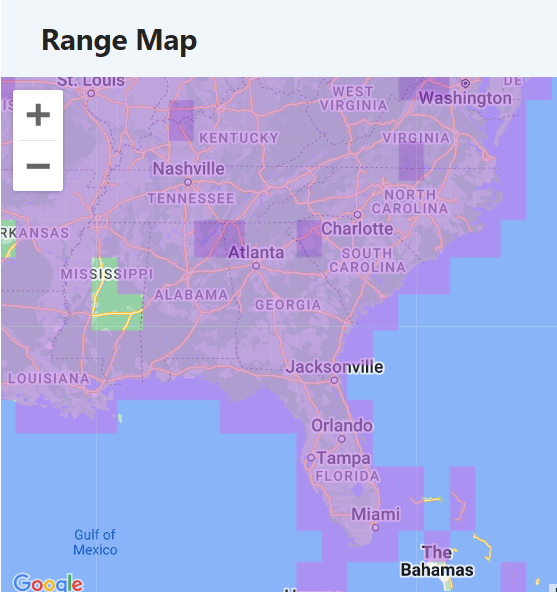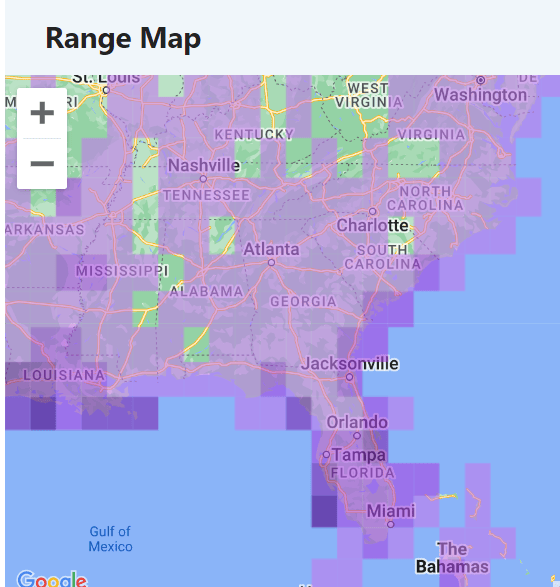According to the U.S. Fish and Wildlife Service, the Southeast is the richest region of the United States in terms of wildlife. These states contain more animals, birds, and fish than the rest of the United States combined! So what are the rare birds in the Southeast?
Despite the extremely vast biological diversity, there are some bird species that pose a true challenge to any bird watcher in the Southeast.
In today’s article, we’ll shed some light on some of the rare birds in the Southeast, so you can be prepared to snap a lucky picture if you ever come across one. So without further ado, let’s hop in!
1. Florida Grasshopper Sparrow (Ammodramus savannarum floridanus)

According to a lot of experts and birders, the Florida Grasshopper Sparrow is by far the rarest bird of Florida and one of the most minimally sighted birds of the southeast. It is a sub-species of the Grasshopper Sparrow, which is classed as Least Concern and is widespread across the southeast, as can be seen in the eBird Range Map below.

While they are very rare in Florida, you can see that there are sightings across the state.
The sparrows are omnivores that can eat both plants and fruits, although they usually pick insects, and especially grasshoppers, as their favorite meal.
Author Note: The Florida Grasshopper Sparrow is a relatively small bird with a rounded head and a noticeably short tail, reaching as little as 13 cm in length when they are fully grown-up adults. They’re mostly brown but have multiple streaks of white, grey, and black.
2. Ivory-Billed Woodpecker (Campephilus principalis)

They’re one of the largest species of woodpeckers in the world and the largest recorded one in the United States in terms of size. However, the Ivory-billed Woodpecker is marked as a critically endangered bird species according to the IUCN Red List.
With few unconfirmed sightings every couple of years and the last official sighting dating back to 2006, some people believe that the Ivory-billed Woodpecker is already extinct.

However, according to some other reports, it’s said that there are less than 35 or 30 Ivory-billed Woodpeckers left in the United State, with most of them in the Southeast.
The huge size of the bird is the most characteristic feature they have. In addition to their size, they also have a unique black feather coat with a unique purplish hue that makes it easily distinguishable in the day.
3. Whooping Crane (Grus americana)

Back in the late 1800s, there were about 1,400 Whooping Cranes living in the region. However, with the urbanization of the Whooping Crane habitat, their numbers began to dwindle to as low as 15 cranes in the mid 20th century.
The wildlife conservation efforts of breeding the Whooping Cranes in captivity and releasing them into the wild help in increasing their numbers again. You’ll have a better chance at spotting the Whooping Crane inside wildlife refuge than outside.

However, the chance is still there, especially if you’re looking at wetlands, wet prairies, marshes, mudflats, and fields towards the northern regions of the southeast, such as Northern Florida, and the Carolinas.
4. Roseate Spoonbill (Platalea ajaja)

The Roseate Spoonbill is commonly mistaken for the pink flamingo. However, you can distinguish it by its very unusual flattened beak.
The State of Florida declared the Roseate Spoonbill as a threatened water bird in the state records. Besides Florida, the Roseate Spoonbill is supposedly found across the coastline of the Gulf of Mexico, including some spots of observation in both Louisiana and Texas.

The main reason behind Roseate Spoonbills’ decline in numbers was hunting, as their feathers were used in the hats industry in the early 1800s. Thanks to the efforts of the Everglades National Park in Florida, the bird’s population has improved and they’re released into their original nesting spots.
5. Sandhill Crane (Antigone canadensis)

The Sandhill Crane is one of the large species of cranes found in North America. They’re given that name because their main habitat was on the edge of Nebraska’s Sandhills on the American Great Plains.
The bird is a former resident of the coastal plains of Mississippi, Louisiana, Alabama, and Florida. However, the only population of the birds is now living in National Park in Jackson County, Mississippi.

Similar to the Whooping Crane, their population reached an all-time low of 30 birds during the 60s due to converting their main habitat into pine plantations. The species are now bred and hatched in captivity before being released.
Despite all these efforts and releasing hundreds of Sandhill Cranes, their population is yet to grow to a stable number.
6. Mangrove Cuckoo (Coccyzus minor)

The Mangrove Cuckoo is often found around the coastlines of the Caribbean, Central America, and the United States’ Southeast. They are known for nesting above mangroves. The cuckoo is known for its elusive nature, which is why they’re also extremely hard to spot.

Author Note: Although they’re best distinguished by their black facial feathers and the buffed up underparts, you can distinguish them from their curved black bill with a yellowish ring around the eye and brown body.
7. Snail Kite (Rostrhamus sociabilis)

The Snail Kite is one of the rarest raptors not only in the southeast but in the United States as a whole.
The males and females of this species are quite distinct. For instance, the male usually has a gray/slate blue back with a white rump while the females have a brownish body with a malar stripe. The bills of the kite are often hooked intensely to help them extract apple snails (their favorite meal) from their shells, hence their name.
The only spot in the United States where the Snail Kites breed is in Florida, especially to the south of Orlando. Their habitat is mostly around the marshes where snails can be found.

This is why they’re typically rare to spot in the Southeast despite being relatively easier to find as you head south towards Mexico, Ecuador, Brazil.
8. Short-tailed Hawk (Buteo brachyurus)

The Short-tailed Hawk is one of the rarest, if not the rarest, species of hawks in the Southeast of the U.S.
These hawks aren’t endangered or universally rare like many of the birds on the list. Although it’s quite rare to spot one in the southeast, it’s quite easy to find them across South and Central America.

They’re closely related to the White-throated Hawk and they both share similar features, such as the shiny white breasts and the black spotting on the wings.
Your chances of spotting the Short-tailed Hawk are always higher as you can move more towards the south, especially at wooded areas that are near medium to large bodies of water.
9. The Limpkin

The Limpkin is another almost Florida dominant bird on the list, which makes it quite rare to spot elsewhere in the Southeast. The only spot outside Florida where spotting a Limpkin might be possible is in the south of Georgia. Limpkins are related to both cranes and rails, which is why they carry both of their traits.

The best time of the day to spot a Limpkin is most at low light settings, such as dusk and dawn while it’s highly unlikely to find one during day or night.
Your best luck at finding a Limpkin is in Floridian wetlands, freshwater marshes, and around the lakes and swamps, as they mainly feed on freshwater mussels and snails, especially the apple snails. They can also feed occasionally on frogs and small lizards.
10. Ruddy Quail-Dove

The Ruddy Quail-Dove is one of the most easily distinguished species in the doves and pigeon family. What’s cool about them is that you’ll instantly recognize one when you see it because it has very characteristic brick-red or rust-colored feathers throughout its body.
What makes the Ruddy Quail-Dove rare isn’t their declining numbers but their vagrant and accidental status in the states of the Southeast.

Author Note: The main breeding range of the Ruddy Quail-Dove is, in fact, in Central America, West Indies, and Caribbean. However, there are a few sightings every year by lucky birders who spot them in from Florida to Southern Texas.
11. The Masked Duck

The Masked Duck has characteristic black color feathers on its head, which makes it look masked. It also makes it quite easy to distinguish if you ever come across one. The bird is more commonly found in South and Central America. However, some Masked Ducks have been spotted near the coastal states of the Southeast, mainly Florida.

Finding a Masked Duck in the Southeast is quite tricky as they’re mostly vagrant and accidental. As can be seen in the eBird Range Map above, they have only been reported in a few spots in the southeast. However, it will still save you the price of a plane ticket to South America!
Wrap Up
With that said, you now have a better idea about the rare birds in the Southeast. Some of these birds are quite rare everywhere in the U.S. while others might be easier to spot in other places.
As you can see, the list contained a huge variety of birds of different types, species, sizes, and habitats, which might help you set a foot in the right direction if you’re looking for a specific one.
Lastly, always remember that some of these birds are extremely rare and average a sighting every couple of years or even decades, so you don’t have to feel stressed out if you didn’t manage to spot some of them. We hope you enjoyed this article on rare birds of the Southeast.
Fly high friends!
FAQ
According to visitflorida.com, some of the endemic birds of Florida are: Florida Scrub-Jay, Snail Kite, Limpkin, White-crowned Pigeon, Smooth-billed Ani. A caveat is that Florida is attached to Georgia and most birds fly so there is always the chance these birds can stray into other states.
A couple of birds that didn’t make our list are: Red-cockaded Woodpecker, Swainson’s Warbler and Black-billed Cuckoo.
I would have to say the Slavonian Grebe. It is stunning and found mostly along the coastlines.










